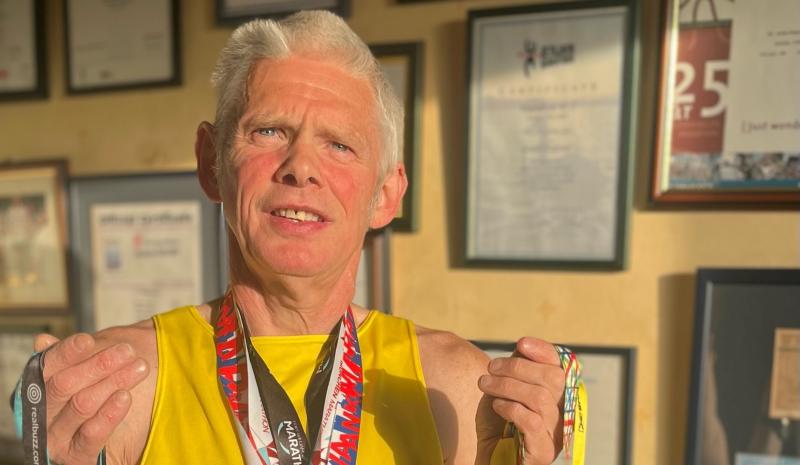News
Shining a light on reality of life with epilepsy

Seven out of ten workers would choose to hide a disability from their bosses, according to a recent study.
Someone who knows all too well about the impact of having a disability that is not immediately apparent is barrister and mediator Lorraine Lally.
The 29-year-old Barna woman has lived with epilepsy since she was eight years old when she began having seizures which could be likened to daydreaming.
“It was just kind of losing time, a lot of clumsiness, I could drop a bowl for no reason. They call them focal seizures because you kind of space out but you can get badly injured. I once poured a kettle of hot water over myself which was very distressing for my parents.”
The See Beyond campaign is a joint initiative of Headway and Epilepsy Ireland, national charities working to support people with two common types of hidden disability, acquired brain injury and epilepsy.
The aim is to raise awareness about hidden disabilities in all communities in Ireland. One in 48 people are estimated to have epilepsy – the west of Ireland has one of the highest rates of neurological conditions in the world.
By the time she went to study law at Griffith College in Dublin, Lorraine had moved onto tonic-clonic seizures, which is when the body the body stiffens and the muscles start jerking.
“It has a serious impact on a family – it’s very distressing to see somebody having these seizures, it can be unnerving, parents and siblings carry a lot of worry with them so they need to have support as well.”
Lorraine remembers all too well the regular trips to Dublin hospitals for treatment as there were no paediatric neurologists in the west, something that remains unchanged even after 20 years. Before being admitted to the epilepsy unit in Beaumont last Christmas for an indepth study of her condition in a bid to improve her treatment, she had been on a waiting list for six years.
Following medication and learning to recognise the triggers for the condition – sleep deprivation, inadequate diet, stress and an unhealthy lifestyle – Lorraine has fewer seizures and now tends to have most of them in her sleep.
She knows she’s had one as her arms and legs are in pain, she struggles to get out of bed and she may have bitten her tongue.
“I fell out of the bed once and slapped my head, and cracked two ribs. I’ll never forget standing at a bus stop and I was so bruised that a woman said to me: ‘you should really leave the bastard’.”
But she has not let it get in the way of her life, going on to get a masters in international human rights law from NUIG.
“I travel, I’ve done the Camino De Santiago twice. I travel on my own and visit friends all over the world. I can’t go out partying all night, a good lifestyle does help manage it.”
Lorraine divides her time between Galway and Dublin working as a barrister and mediator in divorce, separation and immigration cases.
She recently got a grant from NUIG to deliver talks to secondary school students about how to solve conflicts through peer mediation.
She joined the See Beyond campaign in a bid to eliminate a lot of the fear and misinformation around epilepsy.
“There’s a lot of stigma around epilepsy, people I’ve spoken to say they have suffered from a lot of discrimination as a result of it,” she opines.
“I’d urge people not to be afraid to contact organisations like Epilepsy Ireland, they have an amazing community resource officer in the Westside Resource Centre who provides support over the phone or by email.”
Connacht Tribune
West has lower cancer survival rates than rest

Significant state investment is required to address ‘shocking’ inequalities that leave cancer patients in the West at greater risk of succumbing to the disease.
A meeting of Regional Health Forum West heard that survival rates for breast, lung and colorectal cancers than the national average, and with the most deprived quintile of the population, the West’s residents faced poorer outcomes from a cancer diagnosis.
For breast cancer patients, the five-year survival rate was 80% in the West versus 85% nationally; for lung cancer patients it was 16.7% in the west against a 19.5% national survival rate; and in the West’s colorectal cancer patients, there was a 62.6% survival rate where the national average was 63.1%.
These startling statistics were provided in answer to a question from Ballinasloe-based Cllr Evelyn Parsons (Ind) who said it was yet another reminder that cancer treatment infrastructure in the West was in dire need of improvement.
“The situation is pretty stark. In the Western Regional Health Forum area, we have the highest incidence of deprivation and the highest health inequalities because of that – we have the highest incidences of cancer nationally because of that,” said Cllr Parsons, who is also a general practitioner.
In details provided by CEO of Saolta Health Care Group, which operates Galway’s hospitals, it was stated that a number of factors were impacting on patient outcomes.
Get the full story in this week’s Connacht Tribune, on sale in shops now, or you can download the digital edition from www.connachttribune.ie. You can also download our Connacht Tribune App from Apple’s App Store or get the Android Version from Google Play.
Connacht Tribune
Marathon Man plans to call a halt – but not before he hits 160 races

On the eve of completing his 150th marathon, an odyssey that has taken him across 53 countries, Loughrea’s Marathon Man has announced that he is planning to hang up his running shoes.
But not before Jarlath Fitzgerald completes another ten races, making it 160 marathons on the occasion of his 60th birthday.
“I want to draw the line in 2026. I turn 57 in October and when I reach 60 it’s the finishing line. The longer races are taking it out of me. I did 20 miles there two weeks ago and didn’t feel good. It’s getting harder,” he reveals.
“I’ve arthritis in both hips and there’s wear and tear in the knees.”
We speak as he is about to head out for a run before his shift in Supervalu Loughrea. Despite his physical complaints, he still clocks up 30 miles every second week and generally runs four days a week.
Jarlath receives injections to his left hip to keep the pain at bay while running on the road.
To give his joints a break, during the winter he runs cross country and often does a five-mile trek around Kylebrack Wood.
He is planning on running his 150th marathon in Cork on June 4, where a group of 20 made up of work colleagues, friends and running mates from Loughrea Athletics Club will join him.
Some are doing the 10k, others are doing the half marathon, but all will be there on the finishing line to cheer him on in the phenomenal achievement.
Get the full story in this week’s Connacht Tribune, on sale in shops now, or you can download the digital edition from www.connachttribune.ie. You can also download our Connacht Tribune App from Apple’s App Store or get the Android Version from Google Play.
CITY TRIBUNE
Galway ‘masterplan’ needed to tackle housing and transport crises

From the Galway City Tribune – An impassioned plea for a ‘masterplan’ that would guide Galway City into the future has been made in the Dáil. Galway West TD Catherine Connolly stated this week that there needed to be an all-inclusive approach with “vision and leadership” in order to build a sustainable city.
Deputy Connolly spoke at length at the crisis surrounding traffic and housing in Galway city and said that not all of the blame could be laid at the door of the local authority.
She said that her preference would be the provision of light rail as the main form of public transport, but that this would have to be driven by the government.
“I sat on the local council for 17 years and despaired at all of the solutions going down one road, metaphorically and literally. In 2005 we put Park & Ride into the development plan, but that has not been rolled out. A 2016 transport strategy was outdated at the time and still has not been updated.
“Due to the housing crisis in the city, a task force was set up in 2019. Not a single report or analysis has been published on the cause of the crisis,” added Deputy Connolly.
She then referred to a report from the Land Development Agency (LDA) that identified lands suitable for the provision of housing. But she said that two-thirds of these had significant problems and a large portion was in Merlin Park University Hospital which, she said, would never have housing built on it.
In response, Minister Simon Harris spoke of the continuing job investment in the city and also in higher education, which is his portfolio.
But turning his attention to traffic congestion, he accepted that there were “real issues” when it came to transport, mobility and accessibility around Galway.
“We share the view that we need a Park & Ride facility and I understand there are also Bus Connects plans.
“I also suggest that the City Council reflect on her comments. I am proud to be in a Government that is providing unparalleled levels of investment to local authorities and unparalleled opportunities for local authorities to draw down,” he said.
Then Minister Harris referred to the controversial Galway City Outer Ring Road which he said was “struck down by An Bord Pleanála”, despite a lot of energy having been put into that project.
However, Deputy Connolly picked up on this and pointed out that An Bord Pleanála did not say ‘No’ to the ring road.
“The High Court said ‘No’ to the ring road because An Bord Pleanála acknowledged it failed utterly to consider climate change and our climate change obligations.
“That tells us something about An Bord Pleanála and the management that submitted such a plan.”
In the end, Minister Harris agreed that there needed to be a masterplan for Galway City.
“I suggest it is for the local authority to come up with a vision and then work with the Government to try to fund and implement that.”












